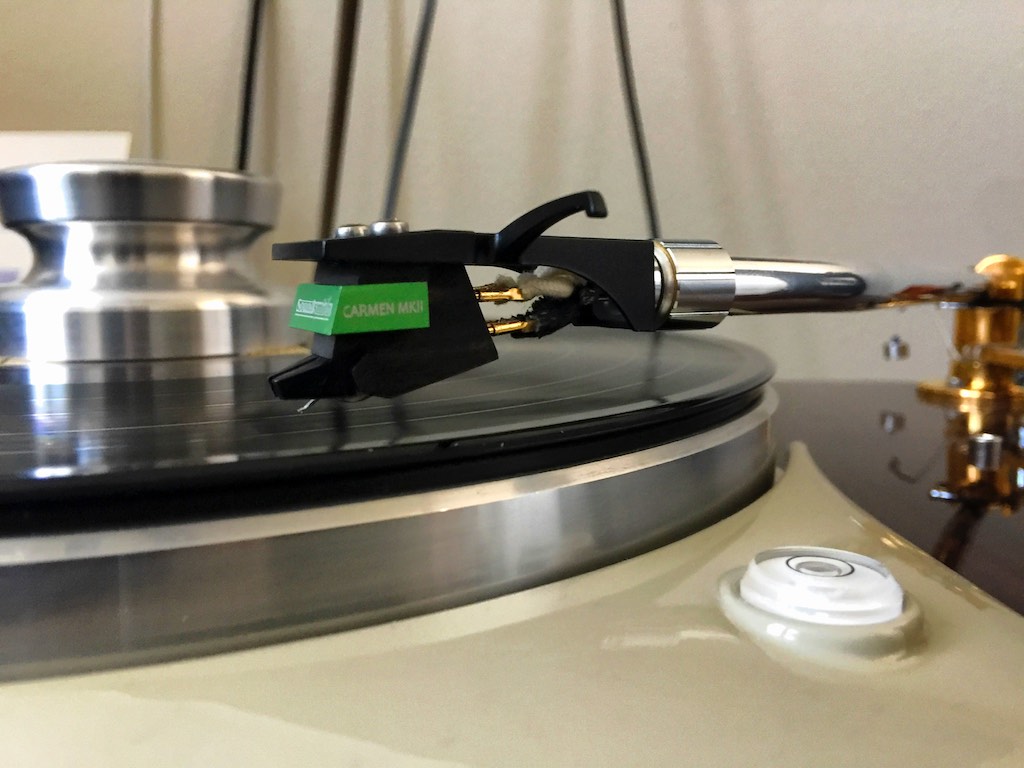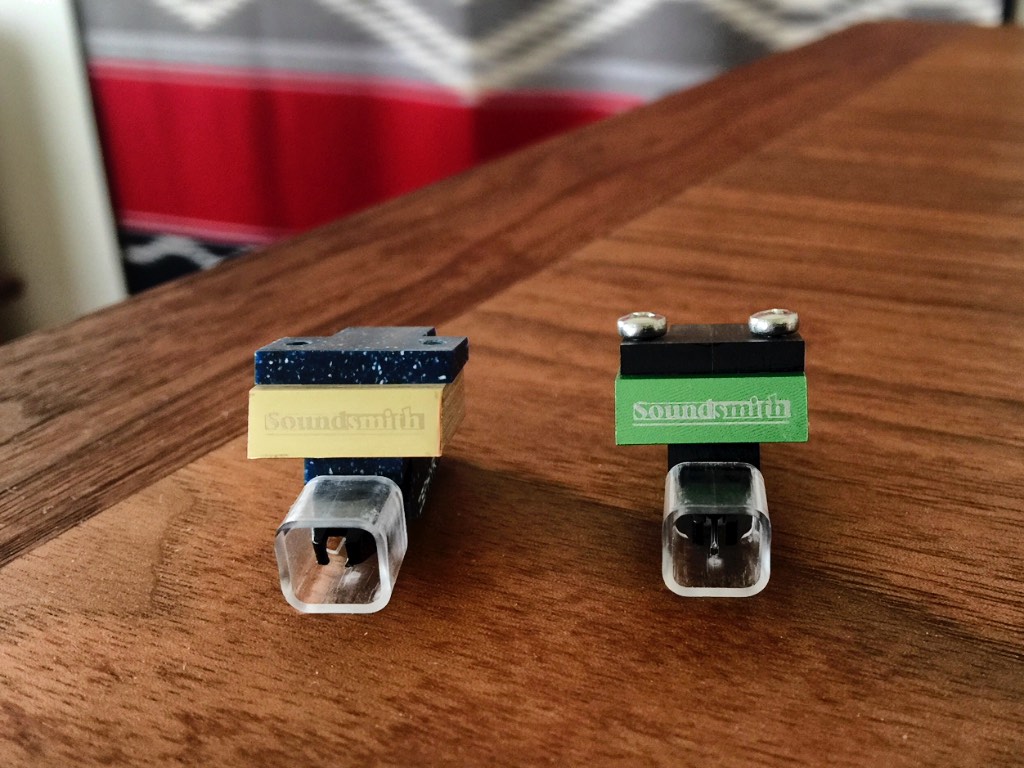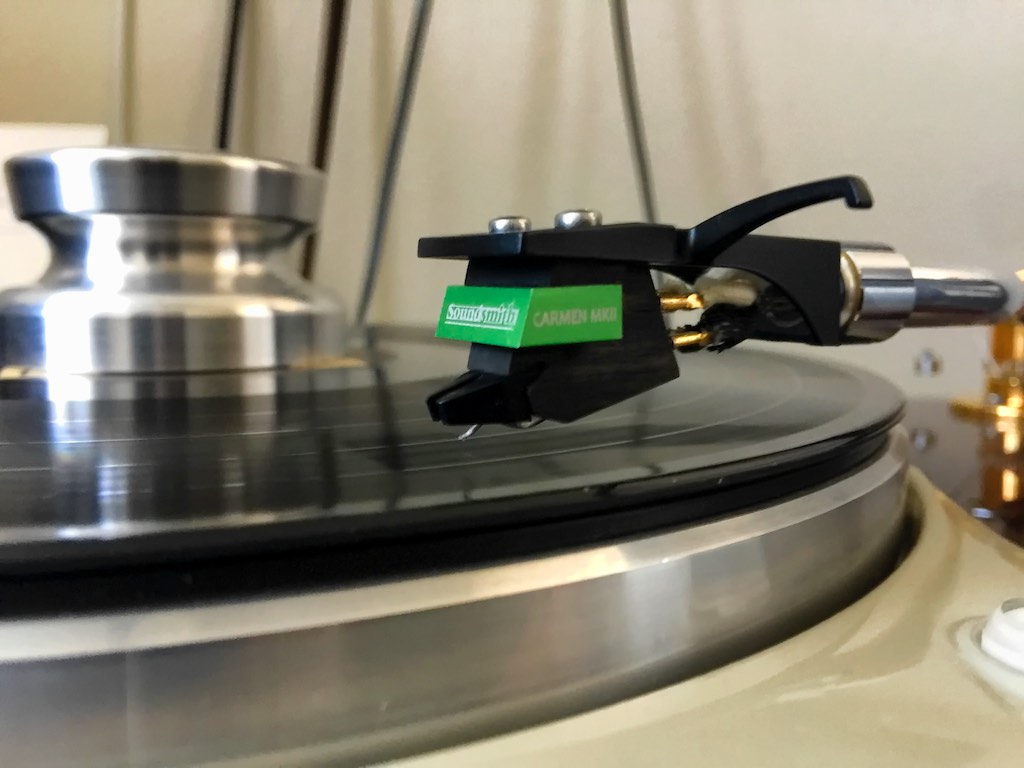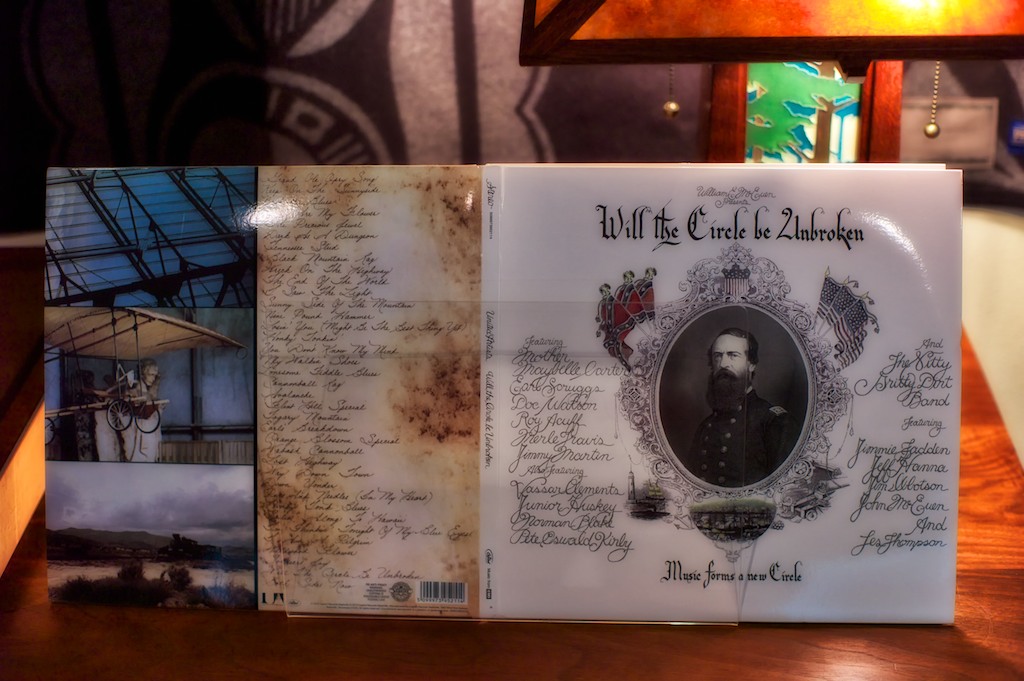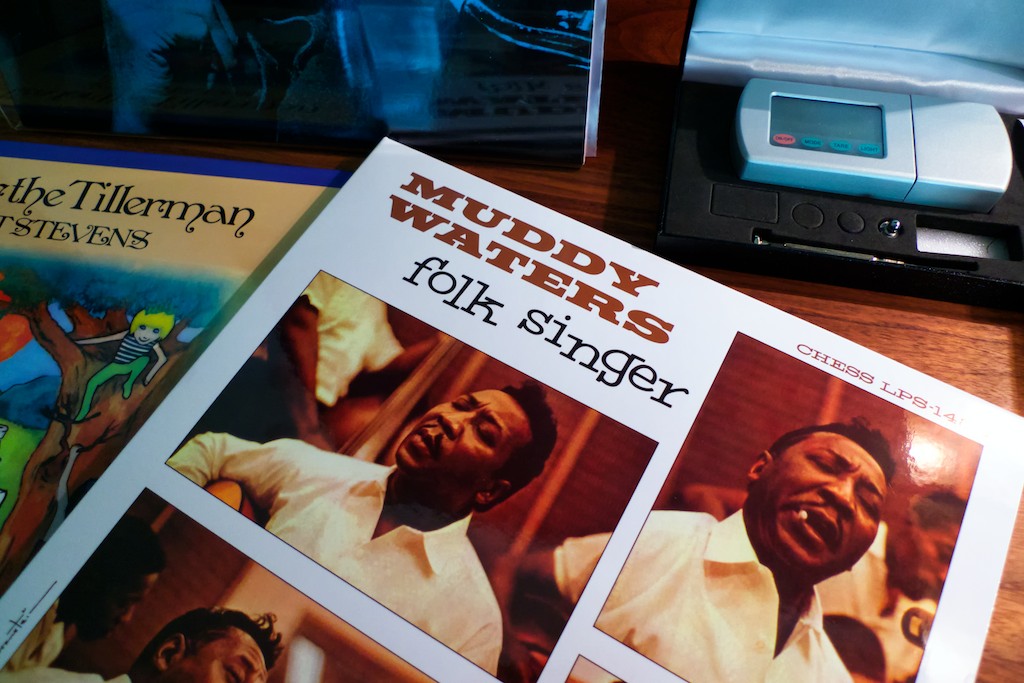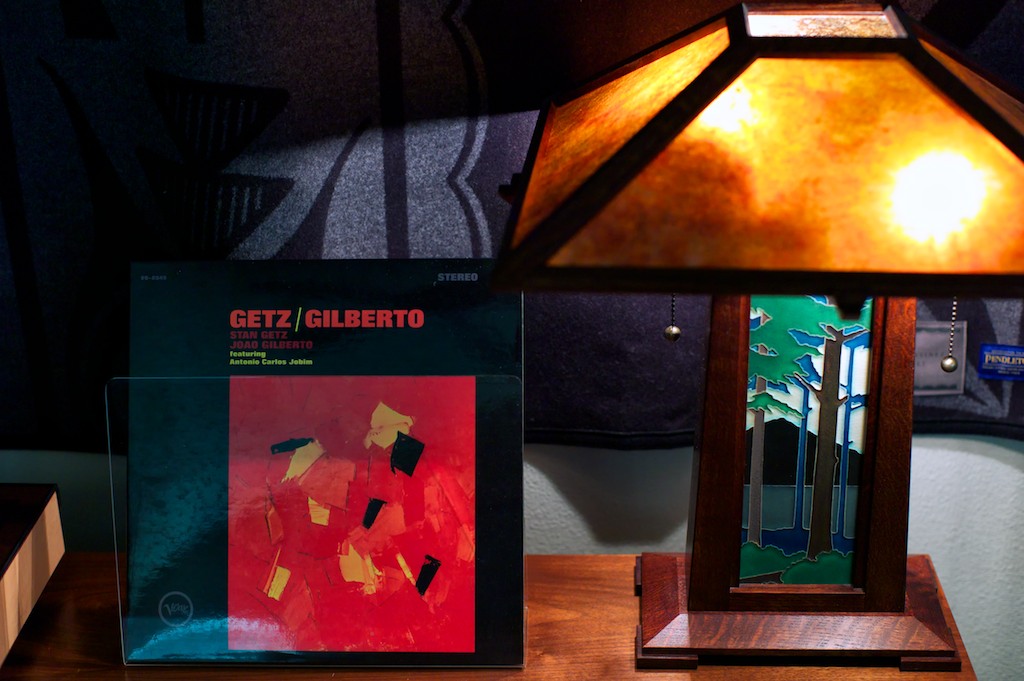As I've reported earlier, I found the Soundsmith Zephyr Mk III phono cartridge to be a match made in heaven for my Leben RS-30EQ valve phono stage, and the Zephyr Mk III has provided the most satisfying analog playback I have ever heard from my A5-based system.
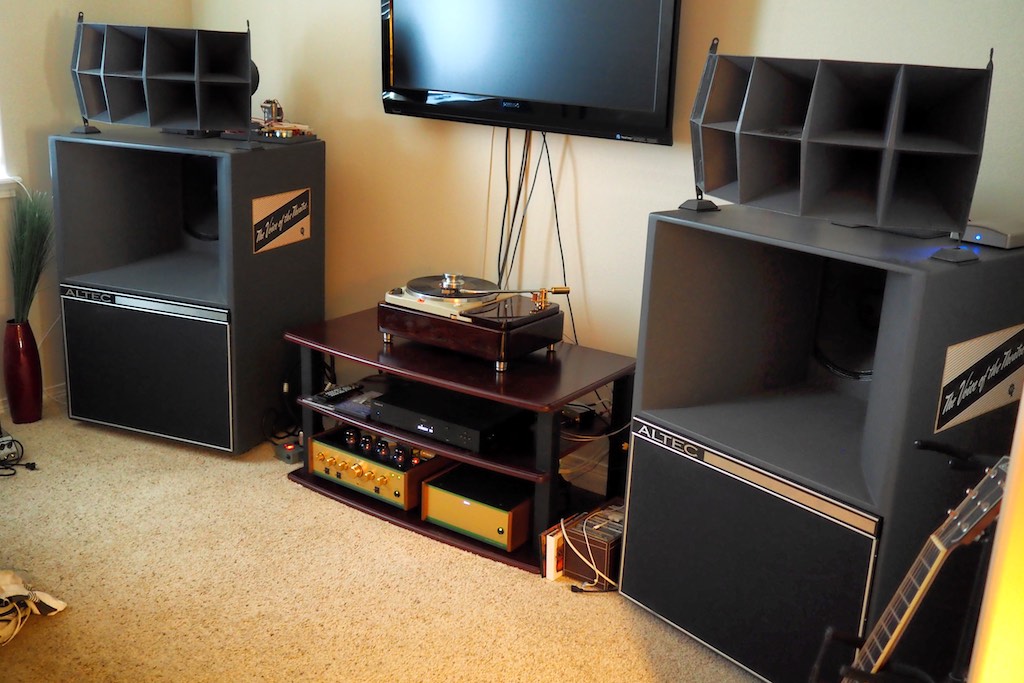
Altec A5 Voice of the Theatre loudspeakers powered by Leben CS600 integrated amp and RS-30EQ phono stage.
Given the superb result with the Zephyr Mk III ($1500 USD), I was eager to give the less expensive Soundsmith Carmen Mk II ($1000) - also a high-output, fixed-coil, moving-iron phonograph cartridge - a listen on my Artisan Fidelity Thorens TD124 turntable in my A5-based system, to get an idea of how its performance compares to the new Zephyr Mk III.
I mounted the Soundsmith Carmen Mk II on the Schick tonearm that I use on my Artisan Fidelity Thorens TD124 turntable and got it adjusted correctly. I used a rather generic headshell, the Audio-Technica AT-HS1 Turntable Lab Edition, with the superb 22GA Art of Tone DIY tinned-copper headshell leads (they don't look like much, but they're extraordinarily musical).
I picked out a few records to kick off some listening: my Analogue Productions test pressing of Chet Baker's Chet, Buddy Guy & Junior Wells' Alone & Acoustic, and Radka Toneff and Steve Dobrogosz's Fairytales.
With the Soundsmith Zephyr Mk III mounted on the Thorens TD124 in my Altec A5 VOTT system, I said previously that it was the best analog performance I'd ever heard from that system.
Now with the Soundsmith Carmen Mk II mounted on the Thorens TD124 in my Altec A5 VOTT system, I'm hearing the most musical performance I've ever heard from this system.
The benefits of eliminating a step-up transformer and an extra pair of interconnects, plus the Zephyr Mk III's & Carmen Mk II's unique high-output, fixed-coil, and moving-iron design, is magic with the Leben RS-30EQ phono preamp (and the rest of the system).
Both of these phono cartridges exceed - by a significant margin - the performance of anything I've tried in this system to date, and I'm rather bowled over by the extraordinary musicality that I'm getting.
I think it may be a happy synergy that both these cartridges have an overall balance that touches on my priorities (rich, natural sounding, colorful, smooth, timbral realism, first rate presentation of tempo, melody, rhythm, harmony, dynamics ...), as well as being perfect matches for the components that make up this system (Thorens TD124 turntable, Leben RS-30EQ phono preamp, Leben CS600 integrated amp, vintage Altec A5 Voice of the Theatre loudspeakers, and Duelund DCA tinned-copper interconnects and speaker cables).
After listening to these cartridges, consider me a believer in Peter Ledermann's approach to phono cartridge design. These high-output, fixed-coil, moving-iron cartridges have extraordinary musicality, and in the case of the Zephyr Mk III, extraordinary sonic performance in terms of resolution, soundstage, imaging, and sense of recorded space (that's what you are paying the extra $500 USD for with the Zephyr Mk III).

Classic Turntable Company hot-rodded "Garrard" 301 in Artisan Fidelity plinth, with Woody SPU tonearm, Schick tonearm, and SPEC platter mat.
The extraordinary sonic performance of the $1500 USD Zephyr Mk III was particularly evident on the CTC Classic 301 turntable (above) in my Tannoy Westminster Royal SE based system, and came reasonably close to the level of performance I was getting from the superb Murasakino Sumile phonograph cartridge plus the Arai Lab MT-1 SUT, an approximately $22,500 combination. That's an extraordinary level of performance from the $1500 Zephyr Mk III - what value!
My Artisan Fidelity Thorens TD124 is a lovely turntable, and I love it a lot, but it is not up to the level of resolution that my über-performing CTC Classic 301 is, where the Zephyr Mk III's sonic prowess is particularly evident.
I now realize that a fair bit of the Zephyr Mk III's remarkable sonic performance goes missing with the Thorens TD124 in my Altec A5 VOTT system, but its remarkable musicality remains completely intact and provides an inspiring performance that really wowed me.
On the CTC Classic 301, the Carmen Mk II mounted on the Schick tonearm, gave my Ortofon SPU Classic GM MkII stereo phono cartridge (with Intact Audio SUT) on the Woody SPU tonearm, a run for its money, meaning the Carmen Mk II is a heck of a good value, delivering nearly the same level of performance for less than 1/3 the price.
I wanted to give you those data points to muse about, but this post is about the Carmen Mk II on the Artisan Fidelity Thorens TD124 turntable in my Altec A5 VoTT system, so let me expand a little more on that combination.
On my Artisan Fidelity Thorens TD124, the enormous level of musicality that the Carmen Mk II is capable of actually surpassed that of the Zephyr Mk III, which is no easy feat.
Every album I listened to pretty much blew me away musically.
As a refresher to those who may be new to how I breakdown component performance during reviews, I partition my perceptions into two broad (and somewhat overlapping) categories: musicality and sonics.
The musicality aspect of a component's performance is related to how well it produces real music in terms of timbral realism at the band level (the band’s signature ‘sound’), and at the individual instrument level (the unique ‘voices’ of instruments), melody (the tune you ‘whistle while you work’), harmony (treble & bass accompaniments to the melody), rhythm (the steady beat that determines the tempo), and I want tempo portrayed realistically so that both the mood and speed of the music are conveyed through it, just like it is with music in real life.
I want dynamics (variations in loudness) to be similar to what I hear in live music, and I want a component to be able to play at live-like loudness levels for a given style of music in a natural and realistic fashion when the music calls for it.
The resolution of tone color is a really important part of overall musicality, as tone color is what gives different styles of music their ‘sound’ and emotional feel.
Specifically, tone color refers to the chordal variations resulting from adding additional pitches to three tone triads, such as major & minor 6ths, major & minor 7ths, dominant 7ths with flat or sharp fives or nines, major & minor & dominant 9ths, 11th's, augmented 11th, 13th, etc.
For example, with simple forms of folk music the tone color is focused is around the sound of major and minor triads, like some of those songs from the Will the Circle Be Unbroken album.
As a musician, maybe you will want to add in an emotive feeling of longing for lost love on a particular song, so then you might add in a major 7th color tone, as some Celtic folk tunes do.
Or maybe you are feeling down and out because of your troubles and sorrows due to that cheatin’ mean woman you love, so you want to add in some blue notes (Eb, F#, Bb) to your folk major and minor triads, and voilà, the blues emerge, so now so you can sing your blues along with Muddy Waters’ Folk Singer for a while.
After singing the blues for a while because of that mean woman you love, you decide to add in some suspended 4th tone color as you seek help from a higher power while singing some gospel music.
Now you are feeling better and are ready to give the good life another go, to strut your stuff, so you change your lyrics and move the beat of the music from two & four to one & three, and play some rock & roll along with the Rolling Stones! Yeah baby!
Maybe you are feeling like getting tonally complex and exploring a little jazz with a major 7th, or adding in a flat five for a little bebop, or adding in a softer Latin tone color with a major 9th so you can play "The Girl from Ipanema: along with Jobim.
Well you get the idea, there’s a reason certain styles of music sound the way they do, and an important part of that has to do with tone colors, so a component's ability to resolve tone color is important to me.
Finally, the ability of a component to relate musicality in a realistic way that creates an emotional response appropriate to the style of music from the listener is key.
Then there's the category of sonic performance that I listen for when reviewing a component. Sonics are mostly related to performance related to the non-musical artifacts of the recording process, like transparency (being able to ‘see’ into the recording), soundstage (the three dimensions of the recorded space in width, height and depth), soundspace (the acoustic ‘space’ of the soundstage), and imaging (the feeling of solidity and localization of instruments & musicians on the soundstage).
If a given component emphasizes sonic performance more than musical performance, it grows tiring for me to listen to before long, as man does not live by soundstaging and imaging alone.
If a given component emphasizes musical performance more than sonic performance, you'll probably love the way it plays music, but you may miss hearing some of the finer recording cues that add to the overall enjoyment of listening.
I think every hifi system & listener will be a little different in what they need and prefer to achieve that perfect balance of musicality & sonics, but for me I know what I like for that balance, and what is needed for system synergy in my different systems to provide complimentary performance.
Ok, with that little refresher let's get back to the Carmen Mk II on the Artisan Fidelity Thorens TD124 in the Altec A5 VoTT system.
My Altec A5 VoTT's are placed close to the front wall and side walls in a fairly small extra bedroom, which means that they'll never be able to produce the kind of expansive, layered, and nuanced soundstage and imaging that they are cable of in a larger room, like my living room that my Tannoy Westminster Royal SE loudspeakers are in.
So in my Altec A5 VoTT system the sonics aspect of performance plays second fiddle to the musical aspects of performance even more than usual, and in particular to that all-important musical triad of tone, presence, and dynamics, which makes music feel and sound real.
In my Altec A5 VoTT system the incredible musicality performance of the Carmen Mk II has made every album I've listened to so far sound extremely real, musically engaging, and emotionally riveting, to the extent that I was rather awed by what I was hearing & feeling as I was listening to records.
The Carmen Mk II's reproduction of timbre, tone color, melody, harmony, rhythm, tempo, dynamics, and loudness is world class, as is its ability to create a strong emotional connection to the listener.
The Carmen Mk II particularly wowed me in terms of tone, presence, and dynamics with my A5's, and made the music feel particularly real and emotionally engaging.
The sonic performance of the Carmen Mk II is also quite good in terms of imaging and soundspace, but as I mentioned earlier, my Altec A5 VoTT's don't really support expansive, layered, and nuanced soundstage and imaging in the smallish room they are in, so some of the sonic performance that the Carmen Mk II is capable of is not fully realized in this particular setup.
What is realized with the Carmen Mk II is an overall musical & sonic balance in my A5 VoTT system that is so complimentary that it makes music listening remarkably emotionally engaging, and mesmerizing in the way it sounds so real in musical terms. I love it!
Long time readers know that I'm a jazz nut, so that forms the basis of a lot of my listening, but I also enjoy folk, blues, gospel, country, rock, etc.
I also enjoy some classical music, but it's not really my thing, so what I haven't done yet is explore how the Carmen Mk II and the Zephyr Mk III performs playing classical music, particularly large-scale classical music, which has its own unique musical & sonic needs from components for the listener to reach musical nirvana.
So next up on my listening schedule is to do some listening to a variety of classical music that I enjoy with the Carmen Mk II and Zephyr Mk III, so I'll report back on that in future posts, and in more detail in the Positive Feedback review.
So stay tuned for more, and as always, thanks for stopping by, and may the tone be with you!





